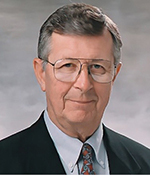
The world has lost a giant in orthopaedics. Newt C. McCollough III, MD, died on April 20 at the age of 89. Those who knew him well knew that he was a gentle giant. Throughout his exemplary career, he was never focused on himself but always on others. Everything he did professionally was with the goal of improving care for patients. As far as his own practice was concerned, he cherished the opportunity to interact with not only a child with musculoskeletal issues but also the child’s family. He understood the anxiety that parents have when their child has a problem, especially if the child required surgery to help resolve the problem. It was always part of his approach to do whatever he could to reduce that anxiety, educating them on the condition and carefully explaining what he was going to do, why he was going to do it, and what to expect.
As a leader, Dr. McCollough was also always focused on others. He felt that he had a responsibility to help those under him to achieve their very best. His well-recognized skill as an effective leader led to his election as president of the Pediatric Orthopaedic Society of North America (POSNA) in 1984 and president of AAOS in 1989. In 1999, he was honored with the Distinguished Achievement Award from POSNA and inducted into the POSNA Hall of Fame.
His career in orthopaedics began when he was in high school. For as long as he could remember, he wanted to be a doctor. This was undoubtedly due to the influence of his father, who was a general practitioner. His father’s practice included a lot of orthopaedics, particularly the management of fractures. He remembered helping his father pin hip fractures. In the community where his father practiced, there was no portable x-ray for the OR, so they had to perform surgery on the x-ray table in the radiology department. Dr. McCollough’s role was to be under the drapes rotating the leg or applying traction as needed. And so, a future orthopaedic surgeon was created.
Dr. McCollough served as a lieutenant commander in Vietnam from 1966 to 1967. He was the commanding officer, D Company, 3rd Medical Battalion, 3rd Marine Division. His service had a very profound impact on him.
He was always a strong believer that an orthopaedic surgeon should also be an orthopaedic physician. He felt that the heavy focus on surgery and the technical aspects of orthopaedics resulted in neglect of patient care. When he was chairman of the Department of Orthopaedic Surgery at the University of Miami, he invited many general orthopaedic surgeons in the community, in addition to subspecialty faculty, to be involved in the education of residents and fellows. He believed that orthopaedic surgeons should be involved, to some degree, in the primary care and nonoperative components of their orthopaedic practices. This included being actively involved in rehabilitative care.
He was asked to address the new members of AAOS in 1999. His speech, titled “Of Geese and Golden Eggs,” was published in the Journal of Bone and Joint Surgery in March 1999. It is a beautifully written presentation and addresses the above in greater detail.
In 1985, Dr. McCollough decided to leave his position at the University of Miami and accepted the role of director of medical affairs for Shriners Hospitals for Children at the headquarters in Tampa, Florida. He missed his first love, which was the privilege of working directly with children and families and making a difference in their futures. He also missed being able to directly teach and mentor residents and fellows, as well as the ability to do clinical research. However, he realized that he had a new opportunity to work on enhancing an entire system of 22 hospitals to improve the care provided to thousands of children.
At that time, care of patients at the hospitals was provided mostly by several highly respected pediatric orthopaedic surgeons on a part-time basis, as there were only two full-time pediatric orthopaedic surgeons on staff. He recognized that the type of patients coming to the hospitals for care was changing. The acuity and complexity of the cases were increasing exponentially, and it was obvious that in order to provide the required care, Shriners Hospitals needed to transition to a full-time care model. Therefore, Dr. McCollough began the process of recruiting outstanding full-time clinicians and surgeons. When he retired at the end of 2000, more than 90 full-time clinicians and surgeons had been hired (60 surgeons and 30 clinicians, including pediatricians, anesthesiologists, etc.). The hospitals’ resources were significantly upgraded to allow them to manage more complex patients in-house, rather than transfer them to affiliate hospitals. He also worked to improve the comprehensiveness of the care provided. For example, children with spina bifida were provided with the full spectrum of care for their various needs at the hospital, rather than being referred to specialists outside the hospital. He also led the improvement of transitional care so that children who had become young adults and still needed care could be transferred to appropriate adult care resources after leaving Shriners Hospitals.
There is so much more that could be said about Dr. McCollough. He was truly a giant in orthopaedics, and his influence on improving the care of children and his teaching and mentoring of pediatric orthopaedic surgeons will be felt for decades to come. He will be missed but certainly not forgotten!
He leaves behind Mary, his loving wife of 56 years; his son, Peter McCollough; daughter-in-law, LeeAnne; grandchildren, Christian and Ashlee Re’; daughter, Amy Busch; son-in-law, Matt; and grandchildren, Camryn and Chloe Busch.
Mary McCollough; Reg Cooper, MD; and Hugh Watts, MD, contributed to the creation of this article.
Peter F. Armstrong, MD, FRCSC, FAOA, FACS, FAAP, is president and emeritus chairman of the board of the Foundation for Advancing Pediatric Orthopaedics and a member of the POSNA Hall of Fame.